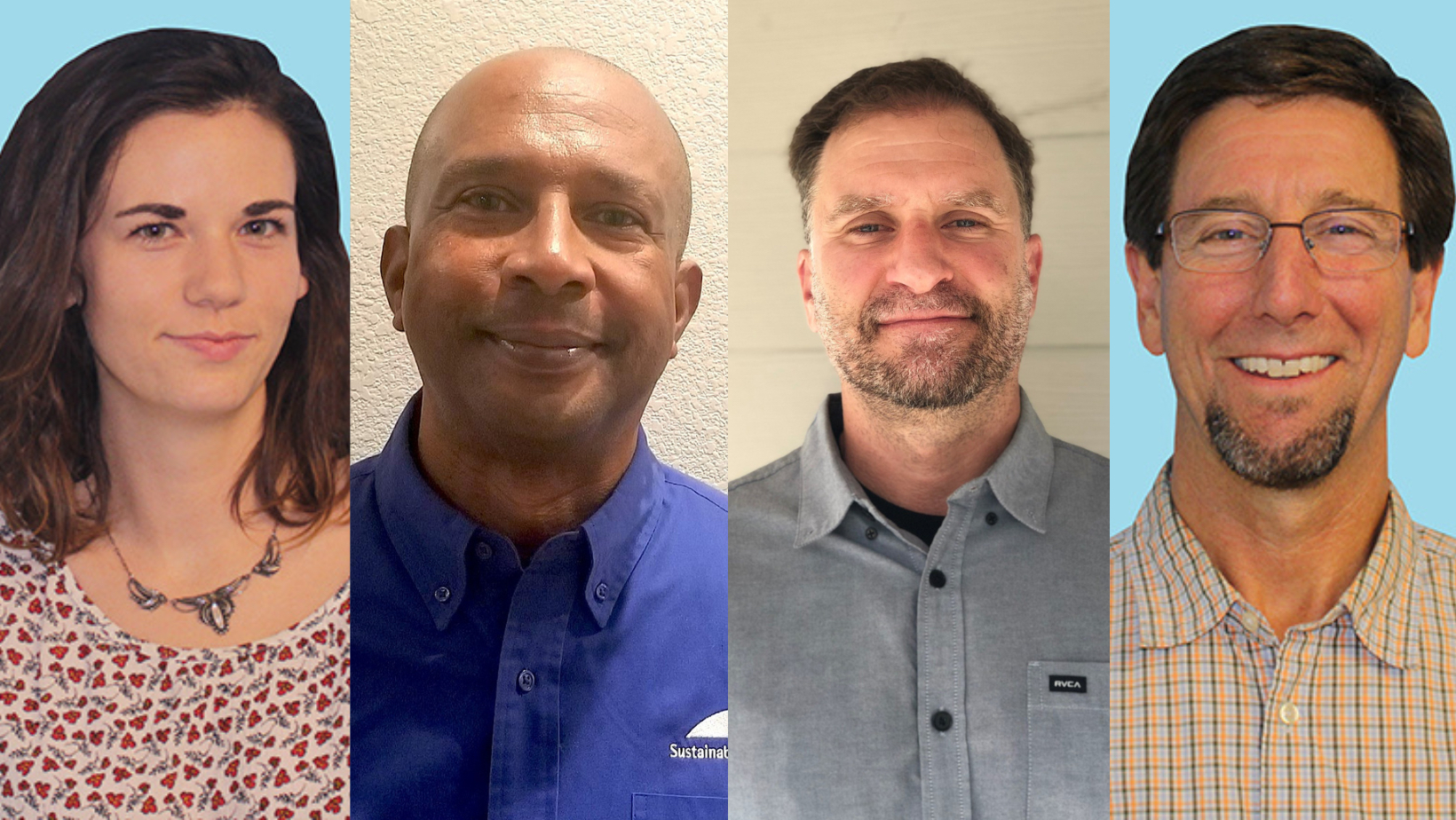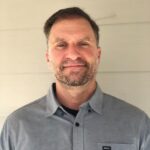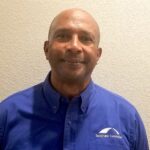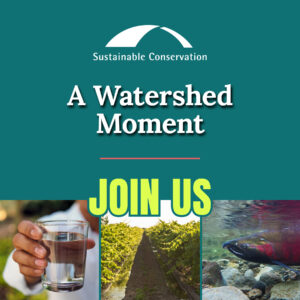
We dove deep into flood risk, floodplain potential, and environmental possibilities with our Water for the Future Program Director Aysha Massell. Now, we’re talking to our entire water team about why our DWR-backed watershed expansion is a watershed moment for Sustainable Conservation, and for California.
We chatted about why scale matters when managing water, what our key role will be in these expansion projects, what the team members are most excited about, and why every Californian should care about the implications of integrated water management.
Why is a watershed approach critical to managing our water resources in California?
 Joe Choperena, Project Director of Water Resources (JC): A watershed approach is critical to managing our water resources in California because its primary goal is to improve and sustain the state’s ability to provide this vital resource for ALL constituents, not just those with the most power and loudest voices, and all the needs in the watershed, for generations to come.
Joe Choperena, Project Director of Water Resources (JC): A watershed approach is critical to managing our water resources in California because its primary goal is to improve and sustain the state’s ability to provide this vital resource for ALL constituents, not just those with the most power and loudest voices, and all the needs in the watershed, for generations to come.
 Daniel Mountjoy, Director of Resource Stewardship (DM): We can’t solve our water problems piece by piece. Water flows from the top to the bottom of a watershed, from the surface to the groundwater, and there’s no way to manage one piece without affecting other parts. What’s innovative about this work now is that we have the tools to consider those multiple pieces, and the trade-offs of focusing on certain goals over others.
Daniel Mountjoy, Director of Resource Stewardship (DM): We can’t solve our water problems piece by piece. Water flows from the top to the bottom of a watershed, from the surface to the groundwater, and there’s no way to manage one piece without affecting other parts. What’s innovative about this work now is that we have the tools to consider those multiple pieces, and the trade-offs of focusing on certain goals over others.
 Rogell Rogers, Agronomist, CCA, PCA (RR): This approach identifies not only groundwater depletion and water quality concerns but also highlights new opportunities in the district where the watershed is located. Also, it promotes the participation and cooperation of stakeholders to engage in concerted efforts to achieve Sustainable Groundwater Management Act (SGMA) and other water policy goals.
Rogell Rogers, Agronomist, CCA, PCA (RR): This approach identifies not only groundwater depletion and water quality concerns but also highlights new opportunities in the district where the watershed is located. Also, it promotes the participation and cooperation of stakeholders to engage in concerted efforts to achieve Sustainable Groundwater Management Act (SGMA) and other water policy goals.
 Taylor Broadhead, Water and Dairy Program Project Manager (TB): What we learned from the Merced Study was that after you do recharge, where that water ends up going depends on what your neighbors are doing. It makes sense to do this work in an integrated way versus working with an individual water district to get a better picture of who’s doing what, and how it affects all the players. Ultimately, we all need to manage our water together, and these customized Groundwater Recharge Assessment Tools can facilitate those conversations.
Taylor Broadhead, Water and Dairy Program Project Manager (TB): What we learned from the Merced Study was that after you do recharge, where that water ends up going depends on what your neighbors are doing. It makes sense to do this work in an integrated way versus working with an individual water district to get a better picture of who’s doing what, and how it affects all the players. Ultimately, we all need to manage our water together, and these customized Groundwater Recharge Assessment Tools can facilitate those conversations.
What’s Sustainable Conservation’s key role in this expansion?
DM: Sustainable Conservation helps water managers who’re focused on single parts think about how the different pieces can fit together. It’s not just water supply, but water supply and flood control and recharge and environmental flows. There’s an agency or organization or advocate for each of those areas, and very few of them are looking to try and balance those different needs.
TB: We’re working with a lot of great modeling teams, but we have deeper connections to the water districts, and hopefully to the communities who’ll be impacted by recharge activities. We’re the link from concept to actionable outcomes, to what’s going on at the ground level, and we have people like Rogell and Joe who can work with farmers and crop advisors to develop larger recharge programs when the studies are complete, and a wealth of knowledge from other districts that we can share.
JC: Our key role in this expansion is to facilitate groundwater recharge in safe and equitable ways for all constituents. We’re utilizing technical information and decision support tools we’ve developed with our partners over the past decade to help reduce potential risks to groundwater quality, crop health and yields, et cetera. We’re also working on policy initiatives to ensure the most amount of success when local stakeholders implement these projects.
RR: We provide the technical know-how information for how to prepare farms to capture, infiltrate and record excess surface flows. We facilitate SGMA and Flood-Managed Aquifer Recharge (Flood-MAR) goals when we work with the Central Valley irrigation districts and farmers to develop on-farm recharge programs. This detailed knowledge is important so water managers can build a successful recharge program that supports willing recharge partners.
What are you most excited about as we work with these new watersheds?
RR: I’m looking forward to building trust among different people and groups, especially between the farmers and other stakeholders in local watersheds.
JC: Same for me, so we can gain the trust needed to collaborate successfully and implement these strategies. It’s extremely rewarding to find ways to connect with these individuals, listen to their local challenges, and brainstorm with them to find ways where we all can succeed.
When we use words like “stakeholders” or “constituents,” what we mean are communities and Native American Tribes, environmental constituents like animals, insects, flora, waterways, woodlands, and grasslands, and businesses that individuals in these watersheds depend on for economic survival and prosperity. We also include water managers, farmers, city and county officials, and environmental and environmental justice organizations.
DM: I’m most excited about starting early in talking with different water managers so they’re not just handed a study, but they can be part of shaping it based on their unique water management goals. They’re more likely to care about the outcome and implement it if they feel heard at the beginning.
I’m also excited about the team we’ve assembled: our Sustainable Conservation staff and Earth Genome partners, and the relationships we have with agencies and other consultants. It’s a large collaborative effort of skilled individuals, and I think we’ll get great results together.
TB: In Merced, we piloted the concept of doing recharge in different management areas, for different objectives: for communities, or shorebird habitat, or flow through basins. I’m looking forward to engaging a lot more people in the environmental community to make sure they’re updated on our methods and what we’re doing, and having real interactions with communities and community organization representatives. Getting more active input and feedback means our methodology will make sense from a modeling standpoint and reflect how people on the ground are seeing the issue.
If you talk to more people, you can learn all sorts of things – water quality concerns, nuances, things you might not hear in one conversation or even from one or a few people. You only know what you know, and it takes some digging to find out what you don’t!
Why should all Californians care about this work?
DM: The resilience of our water supply will affect every single one of us with climate change. If we don’t do this, we’ll see it expressed in food prices, curtailed recreational opportunities, floods, water shortages for municipalities, and all sorts of other challenges in the years to come.
RR: It’s large-scale progress. A big piece of our SGMA challenge is accomplished by irrigation districts, farmers, Pest Control Advisors, and Certified Crop Advisors taking the lead role in popularizing sustainable water practices in production agriculture. We need full collaboration in the statewide effort to restore groundwater quantity and quality.
JC: We should all care about this work because it’s a critical piece of our overall water management needs so we can all adjust to our challenging issues now, and for generations to come. To maintain the diversity that makes our state such a special place, we all must work together.
TB: And really, it’s the simple fact that natural resources cannot go unmanaged, and if they do, we run into real problems. If we want to change how we manage our water, we have to do it right. People who have the least access, the least resources, will and do suffer otherwise.
California has complicated water infrastructure. If water is pulled off upstream, what happens for people downstream? Will there be enough water for them to use, or to drink? Understanding aquifer recharge needs and learning how we can best replenish our groundwater supply while leaving enough for people, fish, and ecosystems – that’s key.
You don’t have to understand all the nuances of water management to know that small changes upstream have big consequences further downstream than you’d think. We’re all connected!
What’s Next?
 This is our watershed moment. Join us!
This is our watershed moment. Join us!
We introduced you to the watershed project as a whole, and chatted with Water for the Future Program Director Aysha Massell. We’ll chat with a Sustainable Conservation supporter on why she gives to empower our water management work, we’ll deliver some more in-depth looks at California’s water complexity, community engagement, and potential policy future.
